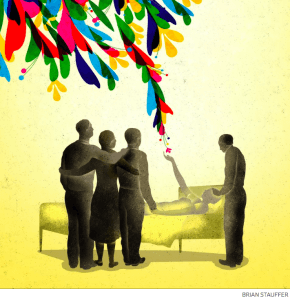The Grand Rapids Press and MLive.com published this piece in their Health section on January 20, 2019
When employees at Emmanuel Hospice received a call for help not long ago, it wasn’t from a family member seeking traditional hospice care for their loved one. Instead, the need was intense and immediate – to counsel workers at Waterford Place, a senior living organization in Jenison, where an employee had died unexpectedly and suddenly. The moment underscored how there are distinct differences regarding how professionals reach out to people enduring both kinds of loss. Grief from sudden death can be a very different experience than that of an expected loss.
“A lot of people aren’t sure how to respond.” said Ashley Huisman, bereavement coordinator and a social worker at Emmanuel Hospice. “In addition to providing counseling to our patients and families, before and after the death, we often provide support to organizations this way. No matter the circumstances, we meet people where they’re at to help them process what can be some challenging feelings.”
Sudden death can take many forms, including loss caused by a traumatic accident, homicide, suicide or the quick onset of illness. It can intensify and complicate the grieving process, prompting some to feel as though “they’re spinning out of control, or that they’re living in a silo, feeling alone,” Huisman said. Those same feelings can surface in response to an anticipated death, as well, she said. “Even when it’s expected, it can still feel sudden to some,” she said. “In either case, it’s important to look and listen for signs, and help those who are affected ‘normalize and become re-grounded.'”
Huisman cautioned that when certain red flags arise, it might warrant calling in others to assist. “When someone says of the deceased that ‘I just want to be with them,’ that’s an OK phrase,” Huisman said. “But when they say, ‘I’ve decided on a way to be with them,’ or they have an action plan to harm themselves or others, they’re definitely not in a good place.”
Certain elements can trigger how we react to a sudden death. They include how the person died, how close the relationship was, whether we witnessed the death, our past experiences with death, how we were informed of the passing and our culture and belief system. A sudden death that occurs around the holidays can create even more challenges. Often, people mourning a sudden loss feel guilty if they don’t want to participate in a family event.
“We help them feel comfortable with expressing that,” Huisman said. “It’s OK that you’re not happy, and that you don’t want to attend, to say that you’re not comfortable with that right now.” Unless you’ve been involved in the aftermath of a sudden death, “it’s difficult to know what a person is going through,” she said. “They feel isolated, or sometimes feel on the edge of insanity.”
Huisman said it’s important to look for “border-line factors” that can include not eating or sleeping for extended periods. “Eating or sleeping too little or too much are, in general, acceptable grief symptoms,” she said. “But it’s not when they start to extend those behaviors – such as gorging or starving – to a point where they may need medical attention.”
“It’s all about meeting people wherever they’re at. It’s (about) being open and accepting and providing the care they need.”
If you or someone you know is in need of grief support, we are here for you. Please give us a call at 616.719.0919 or visit https://emmanuelhospice.org/grief-support
